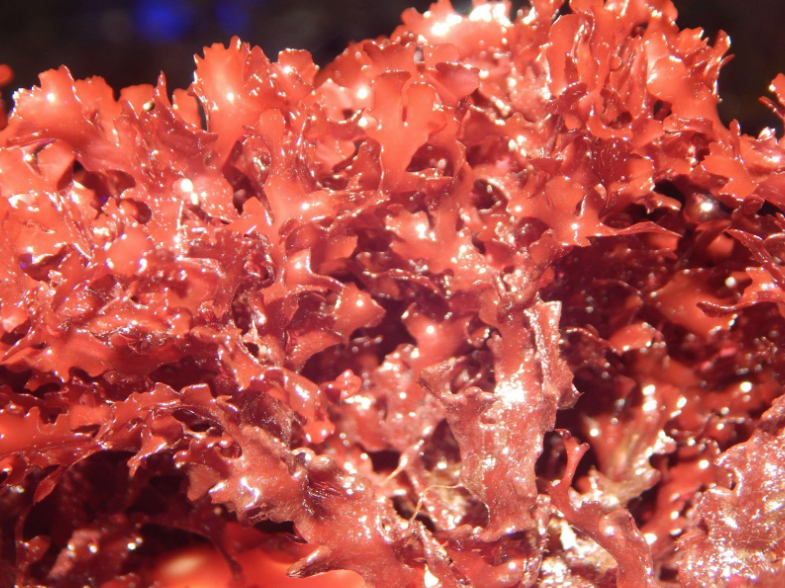Bacteria of the family Vibrionaceae are some of the most universally present microbes in aquatic environments. Even well-established reef aquariums, exhibiting no apparent problems, likely contain a number of Vibrio bacteria species. This is because many species and strains of Vibrio often can perform mutualistic, or even beneficial, operations to various fish, invertebrates, and corals.
The trouble is that this atmospheric benign nature is vastly overshadowed by the negative abilities of many Vibrio species. Vibrio can be highly opportunistic, and many species can and will attack the tissues of plants, algae, animal, and fungal cells. Vibriosis often occurs when a host’s immune system is already being suppressed, either through stress of transport, malnutrition, other diseases, or unfavorable environmental conditions. These same environmental conditions (high temperatures, high organic load, high nutrient load, etc.) facilitate the rapid growth of Vibrio cells, which can then form biofilms and secrete antibiotics to infect the wounds of fish and corals.
Seaweeds (macroalgae) have long been a source of traditional medicines, yet it is only within recent decades that many species are being formally investigated for antimicrobial compounds and/or qualities. The red macroalgae Gracilaria contains several species that have profound industrial value as a raw material source of agar as well as for biofertilizers, wastewater treatment, and agriculture feedstock. The Reef Aquarium Industry is mainly interested in Gracilaria as an ornamental algae which also acts as a feedstock for urchins and herbivorous fish.
Besides its application in macroalgae aquariums, Gracilaira is most often included in the refugiums of bigger reef systems. The purpose of the Gracilaria in these refugiums is to provide an ancillary source of photosynthesis. In high-consumption systems, this can be done to provide a modulation of pH once the main display lights turn off. The photosynthetic growth of the Gracilaria also consumes inorganic nutrients (nitrates, phosphates, etc.) in a way that ‘scrubs’ the incoming water from the display aquarium. There may also be additional…and profound benefits to the interaction of reef aquarium water with Gracilaria tissues. A benefit that is antimicrobial in nature.
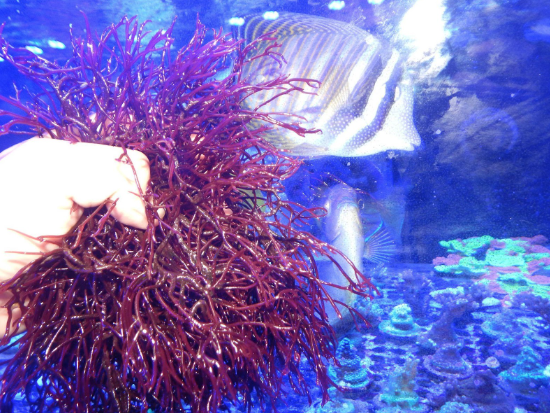
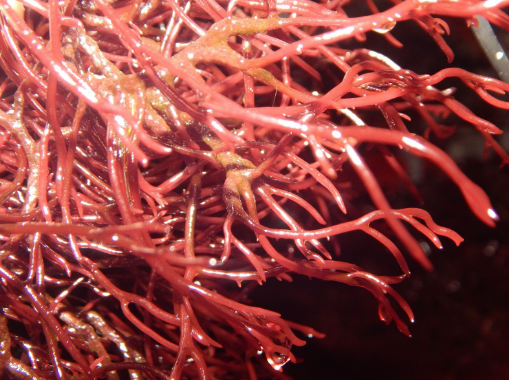
The antimicrobial properties of Gracilaria
There is a mounting body of scientific research investigating the antimicrobial properties of various Gracilaria species. Kamble et al 2022 exposed agar plate colonies of the pathogenic species Vibrio parahaemolyticus and Vibrio harveyi to sulfated polysaccharides isolated from Gracilaria fisheri. The Vibrio colonies exposed to these polysaccharides died, as the compounds disrupted their outer membranes resulting in cellular leakage. Karnjana et al 2022 demonstrated how an ethanol extract from G. fisheri (N-benzyl cinnamamide) was consistently able to prevent biofilm formation in Vibrio harveyi. Cavallo et al 2013 demonstrated how the extract from Gracilariopsis longissima was able to inhibit growth of Vibrio ordalii, Vibrio salmonicida, Vibrio alginolyticus and Vibrio vulnificus in agar plate trials.
Even more interesting, studies intentented for human health applications have revealed that extracts from Gracilaria are able to disable genes that allow various Vibrio species to become resistant to ?-lactam drugs. However, the inhabitants of a reef aquarium are far more complex and precious than a petri dish, and thus, formal live-animal trials are a better indicator of Gracilaria’s potential to thwart pathogenic Vibrio strains.
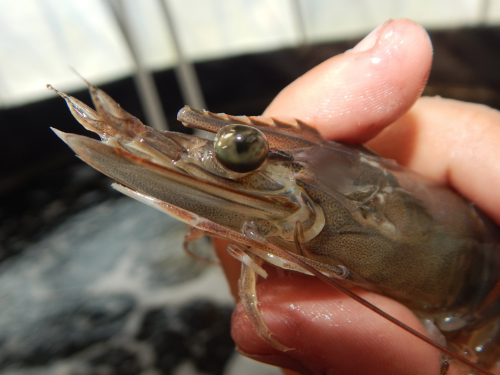
Commercial aquaculture is aggressively exploring avenues to apply the natural antimicrobial powers of Gracilaria. This has become extremely important in the refinement of food shrimp aquaculture, where high stocking densities and heavy feeding often result in mass outbreaks of vibriosis. Many farmers of Pacific white-legged shrimp (Litopaneus vannamei) as well as tiger prawn (Penaeus monodon) have begun experimenting with the inclusion of Gracilaria in their formulated feeds.
Jasmanidinar et al 2018 demonstrated an increased immune response (increased hemocytes, increased phenoloxidase activity, increased phagocytic activity etc.) amongst L. vannamei post larvae fed feeds supplemented with Gracilaria verrucosa compared to a control group. Rudi et al 2019 demonstrated that feeding a G. verrucosa-supplemented diet improved survival of L. vannamei juveniles challenged with Vibrio harveyi infection. The seaweed need not be necessarily added to the feed, as Sirirustananun et al 2011 demonstrated that the extract of Gracilaria tenuistipitata could be dosed directly in the water to improve shrimp survival against a challenge of Vibrio alginolyticus.
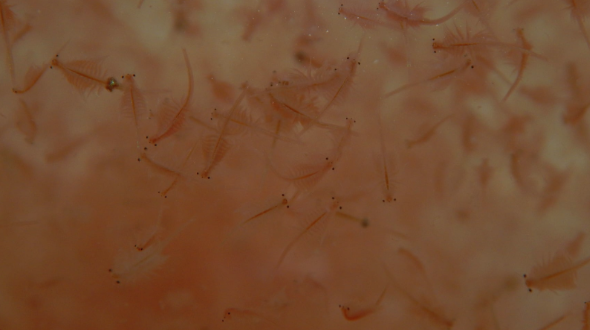
Another limiting factor in commercial shrimp aquaculture is the need for larvae and young juveniles to eat large amounts of live feeds. In many cases, brine shrimp (Artemia sp.) are relied upon. Yet many times, improperly sanitized Artemia cysts (and Artemia cultures) can harbor large amounts of Vibrio cells. Kanjana et al 2011 demonstrated how P. monodon post-larvae fed enriched Artemia exhibited far less mortality when the Artemia had been fed a solubilized extract of Gracilaria fisheri.
Similar results have been found in trials evaluating Gracilaira’s potential to combat vibriosis in fish.
Bakky et al 2023 observed increased survival in juvenile white-spotted rabbitfish (Siganus canaliculatus) fed a polysaccharide extracted from Gracilaria lemaneiformis when challenged with Vibrio parahaemolyticus. This increased survival was associated with the immune stimulation provided by the seaweed extract. Mendonça et al 2019 observed similar results when noting that a 5% inclusion of Gracilairia domingensis in the feed of Lebranche mullet (Mugil liza) resulted in a consistent increase of T-lymphocytes (white blood cells), overall immune competency, survival, and growth rate. Similar studies are being conducted with important commercial fish species such as barramundi (Lates), sea bream (Sparus), and clownfish (Amphiprion). However, the fruits of these early studies have near-universal reach, as recognition of Gracilaria’s antimicrobial properties opens a Pandora’s box of possible applications in the Reef Aquarium Industry.
There is a mounting body of research demonstrating that various Gracilaria species produce compounds that inhibit the growth of pathogenic Vibrio species. Gracilaria is also able to produce compounds that stimulate the immune systems of both vertebrates and invertebrates alike. It is plain to see how the experiments described above can surely translate into preventing Vibrio outbreaks in any fish and invertebrates aquacultured for the Reef Aquarium Industry. In addition, refining these initial observations through future experiments could very well yield new and novel antimicrobial therapeutics.
Compounds isolated from various Gracilaria species will likely be identified, isolated, and purified so that they can be delivered, either via feed or the water column, to combat Vibrio infections and/or stimulate the immune systems of fish/coral/invertebrates. These new seaweed-based therapeutics will be but another tool for the future reef aquarist to yield as they seek means to selectively control one of nature’s most bullish bacteria.
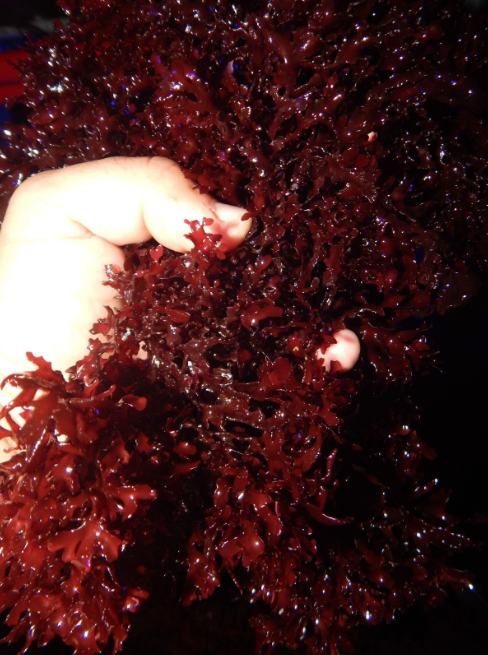
Literature Consulted
Akbary, P., & Sohrabzaei, Z. (2020). Role of dietary inclusion of Gracillaria arcuata extract on growth performance and biochemical responses in grey mullet, Mugil cephalus (Linnaeus 1758). Iranian Journal of Fisheries Sciences, 19(1), 401-409.
Bakky, M. A. H., Tran, N. T., Zhang, Y., Hu, H., Lin, H., Zhang, M., … & Li, S. (2023). Effects of dietary supplementation of Gracilaria lemaneiformis-derived sulfated polysaccharides on the growth, antioxidant capacity, and innate immunity of rabbitfish (Siganus canaliculatus). Fish & Shellfish Immunology, 139, 108933.
Cavallo, R. A., Acquaviva, M. I., Stabili, L., Cecere, E., Petrocelli, A., & Narracci, M. (2013). Antibacterial activity of marine macroalgae against fish pathogenic Vibrio species. Central European Journal of Biology, 8(7), 646-653.
Gonçalves, A. T., Simões, M., Costa, C., Passos, R., & Baptista, T. (2022). Modulatory effect of Gracilaria gracilis on European seabass gut microbiota community and its functionality. Scientific Reports, 12(1), 14836.
Jasmanindar, Y., Sukenda, S., Zairin Jr, M., Alimuddin, A., & Utomo, N. B. (2018). Dietary administration of Gracilaria verrucosa extract on Litopenaeus vannamei immune response, growth, and resistance to Vibrio harveyi. Aquaculture, Aquarium, Conservation & Legislation, 11(4), 1069-1080.
Kamble, M. T., Rudtanatip, T., Soowannayan, C., Nambunruang, B., Medhe, S. V., & Wongprasert, K. (2022). Depolymerized fractions of sulfated galactans extracted from Gracilaria fisheri and their antibacterial activity against Vibrio parahaemolyticus and Vibrio harveyi. Marine Drugs, 20(8), 469.
Kanjana, K., Radtanatip, T., Asuvapongpatana, S., Withyachumnarnkul, B., & Wongprasert, K. (2011). Solvent extracts of the red seaweed Gracilaria fisheri prevent Vibrio harveyi infections in the black tiger shrimp Penaeus monodon. Fish & shellfish immunology, 30(1), 389-396.
Karnjana, K., Soowannayan, C., & Wongprasert, K. (2019). Ethanolic extract of red seaweed Gracilaria fisheri and furanone eradicate Vibrio harveyi and Vibrio parahaemolyticus biofilms and ameliorate the bacterial infection in shrimp. Fish & Shellfish Immunology, 88, 91-101.
Karnjana, K., Nobsathian, S., Soowannayan, C., Zhao, W., Tang, Y. J., & Wongprasert, K. (2020). Purification and evaluation of N-benzyl cinnamamide from red seaweed gracilaria fisheri as an inhibitor of vibrio harveyi AI-2 quorum sensing. Marine Drugs, 18(2), 80.
Lu, W. J., Tsui, Y. C., Chang, C. J., Hsu, P. H., Huang, M. Y., Lai, M., … & Lin, H. T. V. (2022). Characterization and potentiating effects of the ethanolic extracts of the red seaweed Gracillaria sp. on the activity of carbenicillin against vibrios. ACS omega, 7(50), 46486-46493.
Passos, R., Correia, A. P., Ferreira, I., Pires, P., Pires, D., Gomes, E., … & Baptista, T. (2021). Effect on health status and pathogen resistance of gilthead seabream (Sparus aurata) fed with diets supplemented with Gracilaria gracilis. Aquaculture, 531, 735888.
Mendonça, A. J. C. D., Rosas, V. T., Monserrat, J. M., Romano, L. A., & Tesser, M. B. (2019). The inclusion of algae Gracilaria domingensis in the diet of mullet juveniles (Mugil liza) improves the immune response. Journal of Applied Aquaculture, 31(3), 210-223.
Peixoto, M. J., Salas-Leitón, E., Brito, F., Pereira, L. F., Svendsen, J. C., Baptista, T., … & de Almeida Ozório, R. O. (2017). Effects of dietary Gracilaria sp. and Alaria sp. supplementation on growth performance, metabolic rates and health in meagre (Argyrosomus regius) subjected to pathogen infection. Journal of applied phycology, 29, 433-447.
Pramila, S., & Lipton, A. P. (2018). Disease Management Options in Captive Reared Clownfish, Amphiprion sebae Bleeker 1853: Application of Chemotherapy, Marine Natural Products and Autogenous Vaccines. Asian Fisheries Science, 31(3).
Ribeiro, C. B. (2019). Improvement of Gracilaria Gracilis Efficiency As Ingredient in European Seabass Diets (Doctoral dissertation, Universidade do Algarve (Portugal)).
Rudi, M., Sukenda, S., Wahjuningrum, D., Pasaribu, W., & Hidayatullah, D. (2019). Seaweed extract of Gracilaria verrucosa as an antibacterial and treatment against Vibrio harveyi infection of Litopenaeus vannamei. Jurnal Akuakultur Indonesia, 18(2), 120-129.
Silva-Brito, F., Alexandrino, D. A., Jia, Z., Mo, Y., Kijjoa, A., Abreu, H., … & Magnoni, L. (2021). Fish performance, intestinal bacterial community, digestive function and skin and fillet attributes during cold storage of gilthead seabream (Sparus aurata) fed diets supplemented with Gracilaria by-products. Aquaculture, 541, 736808.
Sirirustananun, N., Chen, J. C., Lin, Y. C., Yeh, S. T., Liou, C. H., Chen, L. L., … & Chiew, S. L. (2011). Dietary administration of a Gracilaria tenuistipitata extract enhances the immune response and resistance against Vibrio alginolyticus and white spot syndrome virus in the white shrimp Litopenaeus vannamei. Fish & shellfish immunology, 31(6), 848-855.
Thepot, V., Slinger, J., Rimmer, M. A., Paul, N. A., & Campbell, A. H. (2020). Influence of Seaweed Supplements on the Intestinal Bacteria in the Rabbitfish Siganus Fuscescens: Evidence for a Core Microbiome.
Wijnana, A., Adhika, P., & Kasanah, N. (2018). Bioactivity of Red Seaweed Gracilaria arcuata against Aeromonas hydrophila and Vibrio sp. The Natural Products Journal, 8(2), 147-152.


